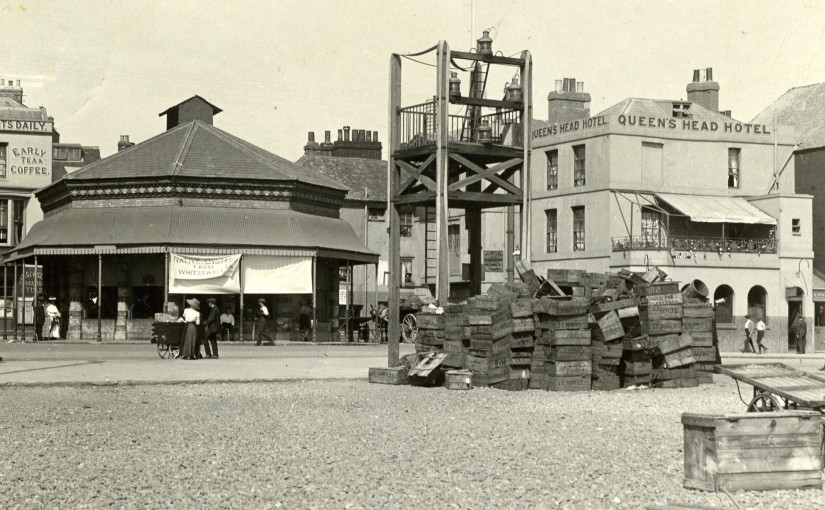EAST BEACH STREET
By John Hodges
The first licence to sell beer was granted to the Queens Head around 1830, at a time that was coincidental with the introduction of the new Beerhouse Act. This piece of sweeping legislation permitted any householder assessed to the poor rate, to obtain from the excise on a payment of two guineas, a licence to sell beer by retail from their dwelling house. It was this act, that was in force until 1869 when once again such matters reverted to the control of the licensing justices, that gave birth to the numerous beerhouses that developed in the streets of Old Hastings and central St.Leonards.
John Tree was the first landlord of the newly converted Queens Head in 1830, although the building itself was in existence prior to 1800. Between these two dates the property served as a warehouse and counting house for both Thomas and James Breeds, and after the dissolution of their partnership in 1809, it served James Breeds alone. James was at this time part owner, together with his son in law Charles Burfield, and two grandsons, of the Phoenix Brewery situated in Courthouse Street. It is therefore very reasonable to assume that the first owner, and supplier of beer to the Queens Head, would have been the Phoenix Brerwery. About this time James Breeds extended the controlling interests in the Brewery to include his brewers, now making a ”board of eight directors”. However the Brewery at this time never had the ownership of the premises’ freehold. In 1837 James Breeds and Charles Burfield were declared bankrupt, this caused them to lose several of their tied houses, including the Queens Head, but not the Brewery itself as it was outside of their ownership.
The purchaser of James Breeds’ tied house following his bankruptcy was William Mantell Eldridge, who a year earlier had taken ownership of Hastings foremost hostelry, The Swan Hotel in High Street. By 1851 the same William Eldridge also owned a brewery, this was the Crown Brewery , opened in 1831 in Shepherd Street St.Leonards. William Eldridge’s excursion into the brewing business did not last very long, and in 1858 the brewery and the public houses that were now associated with it were sold at an auction at the Swan Hotel. It was at this point that the Queens Head most likely came into the hands of Edward Hewett the purchaser of the Crown Brewery, which he subsequently renamed as the St.Leonards Brewery.
Whilst the ownership of the Queens Head was changing hands, so did the tenancy. Gabriel Daniel is recorded as the landlord in 1851, and in addition to his traditional duties he operated a shipping and railway agency, coincidental with the railways first reaching the new town of Hastings. The original address of the Queens Head was described as “on the stonebeach on the east side of the stade”, it eventually became No.1 East Beach Street. This relatively short row of buildings, with the Queens Head standing at the western extremity, at one time contained three public houses, the Jolly Fisherman and the London Trader being the other two. With the Kentish Arms and the Royal Standard in East Street; the Free Trader, the Pelican and the Hastings Arms a few yards away to the west it was very easy to condemn the over population of licensed premises in this small area.
Perhaps the most significant event that happened literally on the doorstep of the Queens Head came in 1870 with the opening of the new “round fishmarket”. This definitely increased the trade of the pubs in the vicinity and gave rise to the 05:00am opening concession. However, despite the availability of this trade, money was inevitably in short supply, and when the fishing was poor virtually everybody struggled to maintain a living. The Queens Head, along with the many other beerhouses in all parts of the Old Town, continued to struggle on until its ultimate demise was signalled by the introduction of the Licensing Act 1904. This draconian piece of legislation sought to drastically reduce the number of licensed premises, mainly created under the relaxed rules of the 1830 Beerhouse Act, that catered to the bibulous habits of a working population, that were deprived of so much that today we all take for granted. All that was needed to close such premises, outside of the usual offences that contravened the licensing acts, was to cite redundancy based upon a count of customer throughput over a number of visits, usually undertaken by the local constable. The proximity of so many beerhouses in such a confined area merely added weight to the redundancy argument.
The Queens Head finally succumbed to this legislation in 1913, when the Licensing Justices referred it to the compensation committee on the grounds of redundancy. Throughout its existence it was probably only ever served by two breweries, The Phoenix and The St.Leonards Brewery which itself went into liquidation in 1907 . In the same year that the Queens Head closed the seven public houses that remained in the Hewett’s estate, the brewery had been run independently between 1907 and 1913, were transferred to the Breeds’ estate. This situation continued until 1930 when Breeds finally purchased the freehold of these houses ready for the sale of their own empire in the following year, to George Beer & Rigden of Faversham. The Queens Head subsequently became a coffee house, a dining room, and until very recently continued to serve the Old Town as a Chinese restaurant.
“Hastings Town” August 2010
All articles, photographs and drawings on this web site are World Copyright Protected. No reproduction for publication without prior arrangement. © World Copyright 2017 Cinque Ports Magazines Rye Ltd., Guinea Hall Lodge Sellindge TN25 6EG
